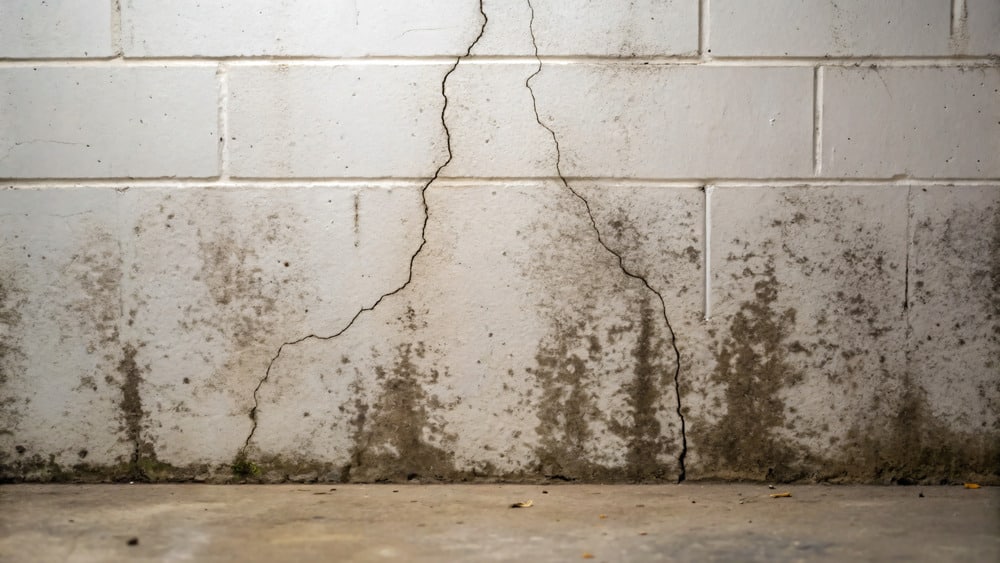
Basement walls offer structural support to your home and are a crucial part of your foundation. They also form a barrier between your home’s foundation and pressure from the surrounding soil and water, keeping your home protected from external elements. Since basement walls are constantly under pressure, they may gradually develop structural or moisture-related damage. There are several professional-grade solutions to tackle basement wall damage, ranging from minor wall cracks to severe bulging. However, the key is to choose the right repair method, one that is specifically designed to address your basement issues. In this blog, we will discuss the top four basement wall repair methods, explaining how each method works and its pros and cons. We will also elaborate on causes and signs of basement wall damage and shed light on how to choose the right repair method.
Common Causes of Basement Wall Damage
Basement wall damage primarily arises from the following causes:
Hydrostatic Pressure
This is the most common cause of most basement wall failures. Hydrostatic pressure is the lateral force that results from the presence of excessive water in the surrounding soil. During heavy rain or snowmelt, the soil around your basement walls retains moisture for extended periods of time and becomes saturated. As the water continues to accumulate, it causes the saturated soil to exert force against the basement walls. This phenomenon gradually weakens the walls, causing them to bow inward. If the pressure continues, it will eventually lead to wall collapse.
Soil Expansion and Poor Drainage
Homes with expansive soil around their foundation are at risk of structural damage. Expansive soils are high in clay, which makes them increase in volume when they absorb water. If your home has drainage issues, water may pool around your foundation. The water is then absorbed by the surrounding soil, causing the soil to expand. This expanding soil gradually pushes your basement walls inwards, leading to bowing or cracking.
Freeze-Thaw Cycles
During the winter, the soil around your home’s foundation freezes and thaws repeatedly. When the water in the soil freezes, it freezes and expands, exerting tremendous pressure on the basement walls. When the soil thaws and dries out, it shrinks. This repetitive freeze-thaw cycle puts constant stress on foundation walls and can cause them to shift and crack.
Poor Construction or Aging Materials
Any compromise in the quality of construction, such as the use of substandard concrete mixes, inadequate structural reinforcement, or insufficient site preparation, can contribute to the failure of basement walls. Using professional-grade construction materials and techniques helps strengthen the structure, enhancing its ability to bear loads and maintain the home’s structural integrity for decades.
Tree Roots and Exterior Forces
If you allow trees to grow near your home, their roots may come in contact with your foundation. These roots can dry out the soil around your foundation, causing it to shift and shrink. If the walls are already weak, the roots may further weaken them and cause cracks.
Top 4 Basement Wall Repair Methods
There are several basement wall repair methods engineered to address specific problems. Here are some of the most common repair methods:
Carbon Fiber Straps
This is a non-invasive reinforcement solution that utilizes high-strength carbon fiber straps to address cracked or bowing basement walls. These straps are incredibly strong and durable. The carbon fiber straps directly bond to the walls, forming an external reinforcement that resists further inward movement.
Pros
- Installation is significantly easy and quick.
- Provides excellent durability and resists further lateral movement.
- Seals minor cracks, helping minimize moisture infiltration.
Cons
- This is a superficial fix and does not address the root cause of the basement wall damage.
- It may not be an effective solution for severe structural damage.
Steel I-Beams (Wall Bracing)
Steel I-beams are used to stabilize and strengthen damaged basement walls. These beams are vertically installed at intervals on the interior of the damaged basement walls. The beams are held in place by steel brackets, which are tightened to transfer pressure from the beams to the compromised walls, thereby providing stability. Once properly installed, this structural support system takes the stress off the walls, effectively stabilizing bulging or bowing walls.
Pros
- This involves a non-invasive installation process where the components can be installed from the inside of the basement without requiring extensive excavation.
- Offers tremendous strength for stabilizing severely bulging walls.
- It is a suitable non-invasive solution for homes with limited exterior space around the foundation.
Cons
- This solution only focuses on stabilizing the wall and does not correct existing bowing.
- The beams occupy usable interior basement space.
Wall Anchors
Wall anchor systems address bowing walls and can even straighten them. A steel plate is installed on the interior wall and connected through a high-strength steel rod to an anchor plate, which is installed in the stable soil outside the foundation. The rod gradually pulls the wall back toward its original position and locks it in place, preventing further movement.
Pros
- This is a permanent solution that offers long-lasting support to leaning basement walls.
- It can actively pull a bowing wall back to its original state and restore its strength.
Cons
- Installation involves significant exterior excavation, which can disrupt the landscape.
- It is not a suitable choice for homes with limited exterior space.
Epoxy or Polyurethane Crack Injection
This solution is used to seal cracks in your basement wall and restore its structural integrity. This solution utilizes specialized epoxy or polyurethane resins that are resistant to temperature fluctuations and moisture. These materials are injected into cracks in the walls, filling the cracks entirely. This can address all kinds of cracks, from hairline cracks to significantly larger fissures.
Pros
- These injections create a permanent, waterproof seal that bonds concrete together.
- It is a minimally invasive solution.
Cons
- This is only a crack repair solution and does not fix walls that are bowing inward.
How to Choose the Right Basement Wall Repair Method
Here are some points to consider when selecting the right basement wall repair method for your home:
Severity of the Damage
The type and extent of damage are the first things to consider when making your choice. For simple non-structural damage, carbon fiber straps or epoxy injections may be effective solutions. However, severe issues like bowed walls will require extensive solutions, such as wall anchor installation.
Budget Considerations
Your budget for the repair job will also influence your decision. While carbon fiber and epoxy injection offer cost-effective solutions for basement wall cracks, wall anchors, and steel I-beam installations are costly. In some cases, choosing the cost-efficient solution may not offer long-term effectiveness. Therefore, it is important to understand the specific needs of your basement walls and address the issue with an effective solution that meets your requirements.
Access to the Interior and Exterior Surfaces
The best basement wall repair method also depends on how easily you can access the interior or exterior foundation. Interior repair methods, such as carbon fiber, epoxy injection, and steel I-beams, are suitable for homes with limited exterior space. Solutions like wall anchors can be effectively used in homes with adequate yard space around the foundation.
Signs You Need Professional Basement Wall Repair
These are the signs you should look for that indicate you need professional basement wall repair:
Horizontal or Stair-Step Cracks
These cracks indicate significant structural stress resulting from external soil pressure. They may range from minor cracks to wider gaps expanding up to an inch or more. Growing cracks suggest wall movement that is ongoing.
Bowing, Bulging, or Leaning Walls
You will notice visible inward bulging or bowing of the basement wall. With persistent lateral stress from the soil, the wall’s deformation becomes more pronounced. This may lead to wall collapse if it is not addressed.
Water Intrusion
If you notice water seeping in through basement wall cracks, it needs professional attention. This compromises the wall’s strength and stability and gives rise to various water-related issues in your basement.
Mold Infestation
Mold growth in your basement indicates hidden moisture problems. Look for the source of moisture. If the moisture is coming from basement wall cracks, you may need professional repair solutions.
Final Thoughts
Choosing between basement wall repair methods does not have to be overwhelming. By determining the cause of basement wall damage, you can easily determine the solution that aligns with your property’s needs. Hiring experts for an evaluation and investing in effective repairs is the best way to ensure long-term protection for your basement.
FAQs
How do I know if my wall is structurally compromised?
If your basement wall is structurally compromised, you will notice signs of damage, such as cracks on the wall, bowing or leaning, water intrusion in the basement, mold infestation, and gaps between the basement wall and floor. If you find any of these warning signs in your home, contact professionals for an inspection without delay.
What’s the best solution for wet basements?
The best solution for a wet basement depends on the specific needs of your basement. Finding the right solution requires a thorough examination of your basement. Depending on the assessment, professionals may recommend installing sump pumps, vapor barriers, dehumidifiers, interior drainage, gutters, or downspout extensions.
Will my homeowner’s insurance cover basement wall repair?
Your homeowner’s insurance may not cover your basement wall repair if the damage is due to negligence or lack of proper maintenance. However, if the damage is caused by sudden events, such as storms or flooding, insurance coverage may apply. Be sure to review your insurance policy to understand the coverage it provides.
Can basement wall repairs increase home value?
Yes, repairing your basement wall can add value to your home. Basement wall repair solutions help restore the stability and structural integrity of your home. Since buyers prefer homes that are structurally sound, a basement repair job can add significant value to your property.










